SportsMed: The reality of MRSA
Staph and MRSA outbreaks among student-athletes are a major concern for colleges and universities. Staph bacteria, and MRSA, an antibiotic-resistant strain of staph, have migrated from hospital settings, where they are commonplace, into locker rooms and athletic facilities infecting high school, college and professional athletes.

Highly contagious, MRSA in particular can be difficult to treat and easily spread from person-to-person or surface-to-person. Healthy student-athletes are key to a successful athletic program meaning infection prevention is critical.
Preventing infections
While hand washing, good hygiene, clean surfaces and bandaged wounds are important, so is properly cleaned and disinfected laundry, according to the Centers for Disease Control (CDC). Prompt cleaning and disinfection of all soiled laundry — towels, loops, clothing and uniforms — stops the spread of infection.The right laundry solution will disinfect contaminated athletic uniforms, personal items, towels, pads and helmets, eliminating viruses and bacteria during the wash cycle. An effective laundry system and good hygiene can lower and help eliminate MRSA outbreaks. The University of Wisconsin-Oshkosh (UWO) averages one MRSA infection per year since the installation of a disinfecting laundry system, compared with as many as 10 in the past.
“Preventing illness and injury is our focus,” said Jack Johnsen, UWO assistant athletic trainer.
Nonetheless, many colleges and universities lack a laundry solution that actually disinfects as it cleans.
Avoiding infection in the wash
With player safety in mind, T-Joe Breaux, assistant athletic director and equipment manager at Rice University, recently installed a laundry system that teams high-speed washer-extractors, ozone injection and commercial drying tumblers to achieve disinfection. It works by infusing a validated amount of ozone gas into the wash cycle at exactly the right time, water temperature and water level. With Rice University’s system, the amount of ozone infused automatically adjusts according to the soil level of each laundry load, maintaining enough ozone to achieve disinfection. That system is clinically proven to kill 99 plus percent of viruses and bacteria in the wash.
“Player safety is my number one priority,” said Breaux. “This extends beyond helmets, pads and cleats. Locker rooms are close-knit and it takes just one contaminated piece of laundry to spread infection. If you don’t have a laundry system that disinfects, you are taking a risk.”
MRSA’s impact
A two-year Vanderbilt University research study recently revealed that 8 to 31 percent of college athletes carry MRSA, and college athletes who play contact sports are more likely to carry MRSA, even if they do not show signs of infection. By comparison, only 5 to 10 percent of the general population carries the bacteria.
Additionally, athletes with MRSA infections generally stay infected for just under 10 days, according to the MRSA Research Center at the University of Chicago Medical Center. During that time, they cannot practice or play in games. When antibiotics don’t control staph and MRSA infections, other serious complications can occur. Approximately 19,000 people die each year due to MRSA.
Staph has taken down many healthy athletes, according to Ric Bucher, of ESPN The Magazine. These players include MLB players Sammy Sosa and Álex Riós; and NBA players Rudy Gay, Shane Battier and Kenyon Martin.
There’s also the $20 million lawsuit against the Tampa Bay Buccaneers by former kicker Lawrence Tynes. In 2013, he contracted a MRSA infection in his toe that prematurely ended his career. That same year, two other Buccaneers suffered MRSA infections.
More recently, MRSA reared its ugly head at Steinert High School in Hamilton Township, New Jersey. The outbreak affected 11 students and put three in the hospital, according to CBS.
Choosing laundry equipment
When colleges and universities look for laundry equipment, they should first consider the most important aspect — disinfection.
IMG Academy, a college preparatory school in Bradenton, Florida, just installed a disinfecting system in its new field house.
“Because it doesn’t just clean, but truly disinfects dirty laundry in the wash, the system helps prevent the spread of infection to student-athletes from contaminated laundry,” said Equipment Manager Cortez Robinson.
Determine if the laundry equipment you’re considering is proven to disinfect and kill bacteria and viruses. If it isn’t, keep looking.
Second, seek a laundry solution that offers solid programmability and automatic chemical injection. Once individual programs are set up for cleaning towels, uniforms, loops and practice gear, users can just load the washer, select the appropriate program number and press start.
There will be times when student workers and coaches operate laundry equipment, so a highly programmable system makes it “dummy proof.” That way, a load of uniforms is cleaned exactly the same way no matter who is operating the washer. This reduces human error and eliminates damage to expensive uniforms and fabrics.
Some laundry systems offer programmable quarter- and half-turn rotation options. This allows facilities to disinfect bulky items.
“Washing helmets and shoulder pads is one part of the reconditioning process that I can do in-house,” Robinson said. “I put the helmets in the washers programmed for a quarter-turn rotation. The washers combine the ozone and detergent to disinfect the helmets. Once washed, the helmets are air-dried.”
Because ozone infusion is critical to attaining disinfection, ensure the laundry solution you purchase validates the levels of ozone in the wash. In other words, be sure it automatically adjusts ozone levels according to the soil content of the load and validates that disinfection is achieved.
Ozone (O3), which is a gas that can destroy bacteria and viruses, is commonly used to disinfect wastewater, according to the U.S. Environmental Protection Agency (EPA). It works the same way to disinfect athletic laundry as part of the washing process. It’s also good for the environment, as it decomposes rapidly and leaves no harmful residual to remove after treatment.
Formed when oxygen molecules (O2) collide with oxygen atoms to produce ozone (O3), it’s more effective than chlorine in destroying viruses and bacteria, according to the EPA. However, the EPA warns, “Low dosages may not effectively inactivate some viruses, spores and cysts.”
Also look for productivity in your laundry solution. You don’t want contaminated laundry piling up. By properly sizing laundry equipment to match productivity needs, colleges will easily keep pace with dirty laundry. Look for washers with high extract speeds of 300 to 400 plus G-force. As a washer’s extract speed increases, so does the amount of water removed from every load, which shortens resulting dry time and improves productivity. Many uniforms shouldn’t be dried in the first place. When they come out of a high-speed washer, they’ll line dry very quickly, which is important.
Tim Toon, head volleyball coach at Walla Walla Community College (Washington), maintains a new laundry system on campus has cut the time it takes to complete laundry by 25 percent. Before the new laundry equipment, uniforms were hung and air-dried overnight. He also reports that with the new system, a load of towels are cleaned, disinfected and dried in just 50 minutes.
Remember that there are very efficient laundry solutions out there. Some can cut water usage by up to 50 percent and hot water usage by 30 percent. Keep in mind that when you cut hot water usage, you also decrease natural gas consumption and resulting costs. An efficient system will give you a much quicker return on your investment. Additionally, by selecting a solution with washers that generate high G-force extract speeds, you’ll cut resulting dry time, related natural gas consumption and elevate laundry productivity.
Steve Leib, national sales manager at Sports Laundry Systems, is a retired high school teacher and college football coach.





